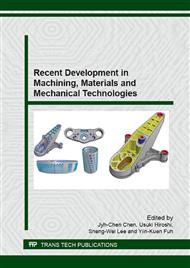p.266
p.271
p.277
p.283
p.289
p.296
p.302
p.308
p.314
Improving the Polishing Effect of Stainless Tube by Magnetic Finishing with Gel Abrasive
Abstract:
Magnetic abrasive finishing (MAF) is a fast and high-precision polishing method. However, the magnetic force acting on abrasive particles will decrease remarkably when polishing stainless steel tubes with the property of non-permeability, such as the SUS304 stainless steel. Moreover, the abrasive particles will be moved off the surface of machining area due to the centrifugal force of rotation, resulting in reducing the stability of polishing process. Therefore, this study developed a novel approach by adopting different gels as the bonding materials to combine the magnetic abrasive particles with hard abrasive particles to create a series of magnetic abrasive gels. Generally, those abrasive gels have higher viscosity to dominate the flow property that will constrain uniform motion of the abrasive particles in MAF, and the abrasive gels can be tightly contacted to the wall surface to increase the stability of polishing. This investigation utilized the optimal parameters out of Taguchi method to polish SUS304 stainless steel tube for 30 minutes—the value of surface roughness can be reduced from 0.636μm Ra to 0.05μm Ra, which can be improved by 92.1%, and the amount of material remove rate is as high as 218.4mg.
Info:
Periodical:
Pages:
289-295
Citation:
Online since:
July 2015
Authors:
Price:
Сopyright:
© 2015 Trans Tech Publications Ltd. All Rights Reserved
Share:
Citation:


